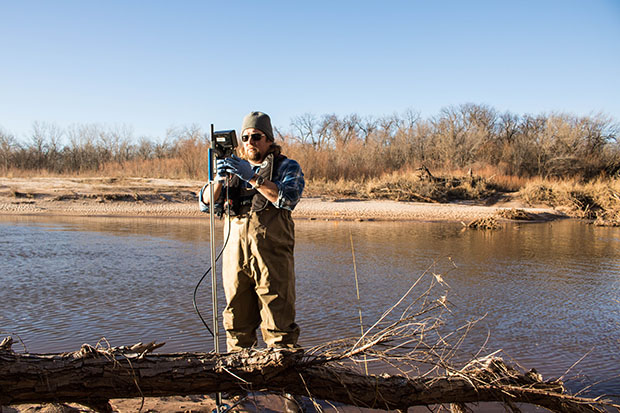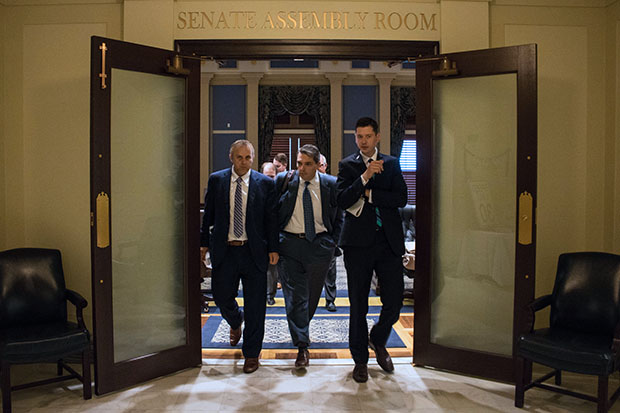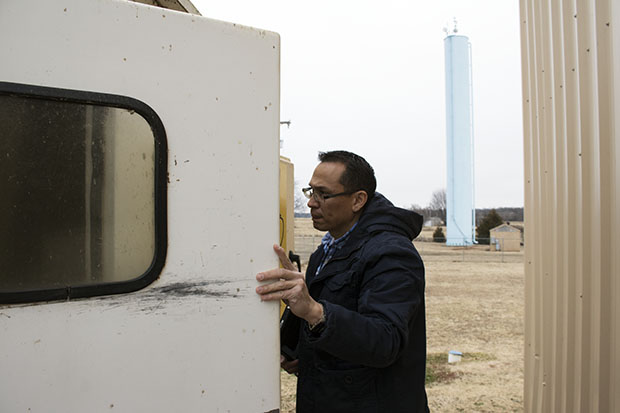
Oklahoma Water Resources Board project coordinator Jason Murphy takes water samples at the Canadian River east of Oklahoma City.
Joe Wertz / StateImpact Oklahoma


Oklahoma Water Resources Board project coordinator Jason Murphy takes water samples at the Canadian River east of Oklahoma City.
Joe Wertz / StateImpact Oklahoma

Joe Wertz / StateImpact Oklahoma
Oklahoma Water Resources Board project coordinator Jason Murphy takes water samples at the Canadian River east of Oklahoma City.
After months of deliberation and closed-door meetings, lawmakers in the Oklahoma House and Senate are poised to cut a deal to fill a $1.3 billion shortfall and fund government for 2017.
The $6.8 billion presumptive budget agreement has been praised for preserving money for education, prisons and Medicaid, but some of the sharpest cuts are aimed at agencies that regulate industry and protect the environment.
Outfitted in rubber waders on a frosty winter morning in the middle of nowhere, Jeanette Lamb with the Oklahoma Conservation Commission kicks up a pile of mud from the riverbed at Walnut Creek, along a farm in rural McClain County.
She stares deeply into the mud, searching for a light-brown critter whose big mandibles pack a punch.
“That’s what I’m looking for,” she says, before warning, “They bite. It’s a Dobsonfly larvae.”
The kinds of bugs she finds — or doesn’t find — says a lot about the health of this stream.
“They cannot tolerate pollution at all,” she says. “They’re very sensitive.”
If Lamb finds something wrong, she’ll work with local landowners to identify the pollution source. She didn’t find any problems here during her inspection last winter, at least with the wildlife. But her agency’s budget situation is another story, according to the Conservation Commission’s Water Quality Manager, Shanon Phillips.
“[In] 2009 we had a staff of 40 people,” Phillips said. “We now have a staff of 25. Future cuts would mean further reductions in staff.”
The Conservation Commission will likely receive a 9 percent cut, and the agency’s director Trey Lam says it already operates on a barebones budget.
“Currently 20 percent of the state’s Conservation Districts are sharing employees, including seven districts that have no staff,” Lam says. “Our ability to protect our natural resources and maintain our flood control system is at risk.”
The new cuts could hurt the commission’s ability to monitor the health of small waterways and maintain more than 2,000 flood-control dams across the state.

Joe Wertz / StateImpact Oklahoma
State Senators Greg Treat, Clark Jolley and David Holt emerge from a Republican Caucus meeting after members agreed on a framework for a $6.8 million state budget.
Even steeper reductions are likely coming for other environmental and regulatory agencies. The Department of Mines and the Water Resources Board are on tap to have their state funding reduced by 12 percent.
“We will probably have to scale back our monitoring a little more,” says OWRB executive director J.D. Strong.
The funding cuts will degrade the Water Board’s ability to monitor the health of lakes, rivers and streams, Strong says. The state’s water regulator will likely have to slash the amount of money available for its Rural Economic Action Plan program, which grants money to local water managers who need to make expensive fixes to their crumbling water systems. Strong says the REAP account will be cut by at least $400,000.
“That will mean fewer grants that we’re able to provide to really small, rural communities across the state to help them improve wastewater and drinking water infrastructure,” Strong says.

Joe Wertz / StateImpact Oklahoma
Vance Pennington, a regional manager for the Oklahoma Department of Environmental Quality, inspects a chlorine treatment system at a water treatment plant in Chandler, Okla.
The cuts could hurt other agency programs designed to fix water problems in small communities. The Department of Environmental Quality also faces a 12 percent reduction.
“What will suffer in the longer term if we continue to receive general revenue cuts, is our ability to do some of the things that especially the smaller communities rely on the most,” DEQ’s Deputy Director Jimmy Givens told StateImpact in February as the 2016 legislative session was about to start.
Many of the DEQ programs protecting Oklahoma’s air and land are paid for with fees and federal dollars, but oversight and inspection of local water systems is funded by state revenue. Cuts to state funding disproportionately affect DEQ programs that make sure local water supplies are safe to drink, and that wastewater discharged from municipal and industrial sources isn’t polluting the environment, Givens said.
In response to years of budget cuts, DEQ has closed field offices. It used to have 39, it now has 22. The agency has also sharply reduced its roster of inspectors — from 89 to 58 — that monitors community water systems, which struggle to keep up with increasingly strict federal rules.
If DEQ can’t ensure clean drinking water for Oklahomans, the harder-nosed U.S. Environmental Protection Agency could step in and takeover. That’s a last resort, but it could be a big challenge for small towns used to the state agency’s soft touch.
“EPA has the residual right to come in and do enforcement,” Givens said. “Nobody particularly wants that.”

Logan Layden / StateImpact Oklahoma
Harold and Amy Coulter with their granddaughter at Walnut Creek State Park, which closed due to budget cuts in October 2014.
The Oklahoma Department of Tourism and Recreation is also in line for a 12 percent hit to its state funding.
The agency has responded to previous budget cuts by shedding state parks. This year, officials have considered turning over some small parks near Grand Lake to the Grand River Dam Authority. Spokesperson Leslie Blair says that’s still a possibility.
“At this point it’s too soon to know what our exact approach is going to be,” she says. “We’re taking a look at the bill and seeing what those numbers are.”
Agency leaders say the 2016 budget agreement outlined in Senate Bill 1616 chips away at a funding stream that’s been declining for years. At the same time, the responsibilities of those agencies are increasing as the federal government imposes stricter environmental rules.
Officials say some environmental and regulatory programs could disappear. Even whole agencies aren’t safe. The Scenic Rivers Commission had all its funding stripped in 2016 and will cease to exist on July 1.
The Grand River Dam Authority will assume its responsibilities — and employees. GRDA CEO Dan Sullivan was shocked when he first saw the budget the Scenic Rivers Commission was working under.
“I can’t imagine that they’ve been able to do what they have done on the budget they have,” Sullivan said.